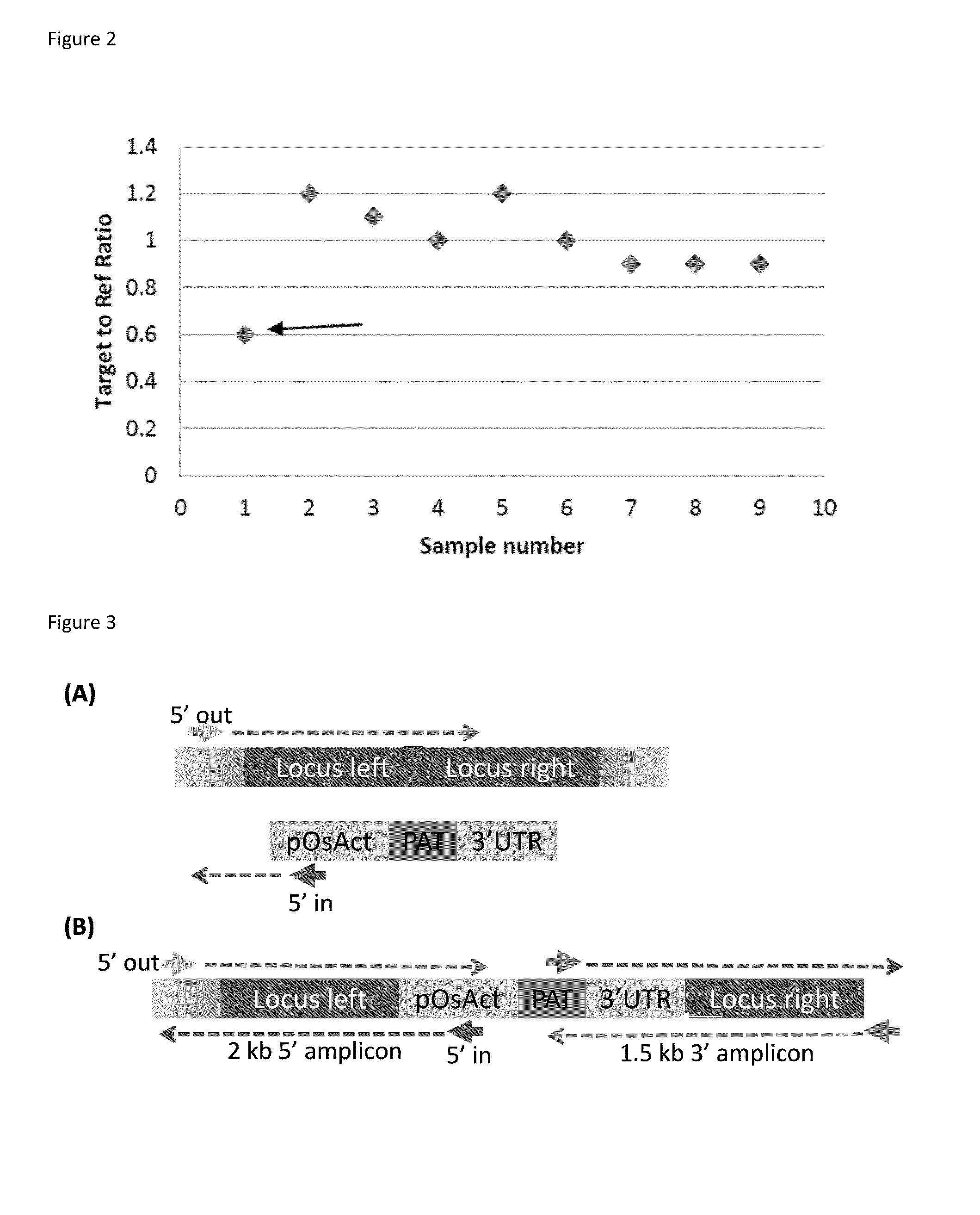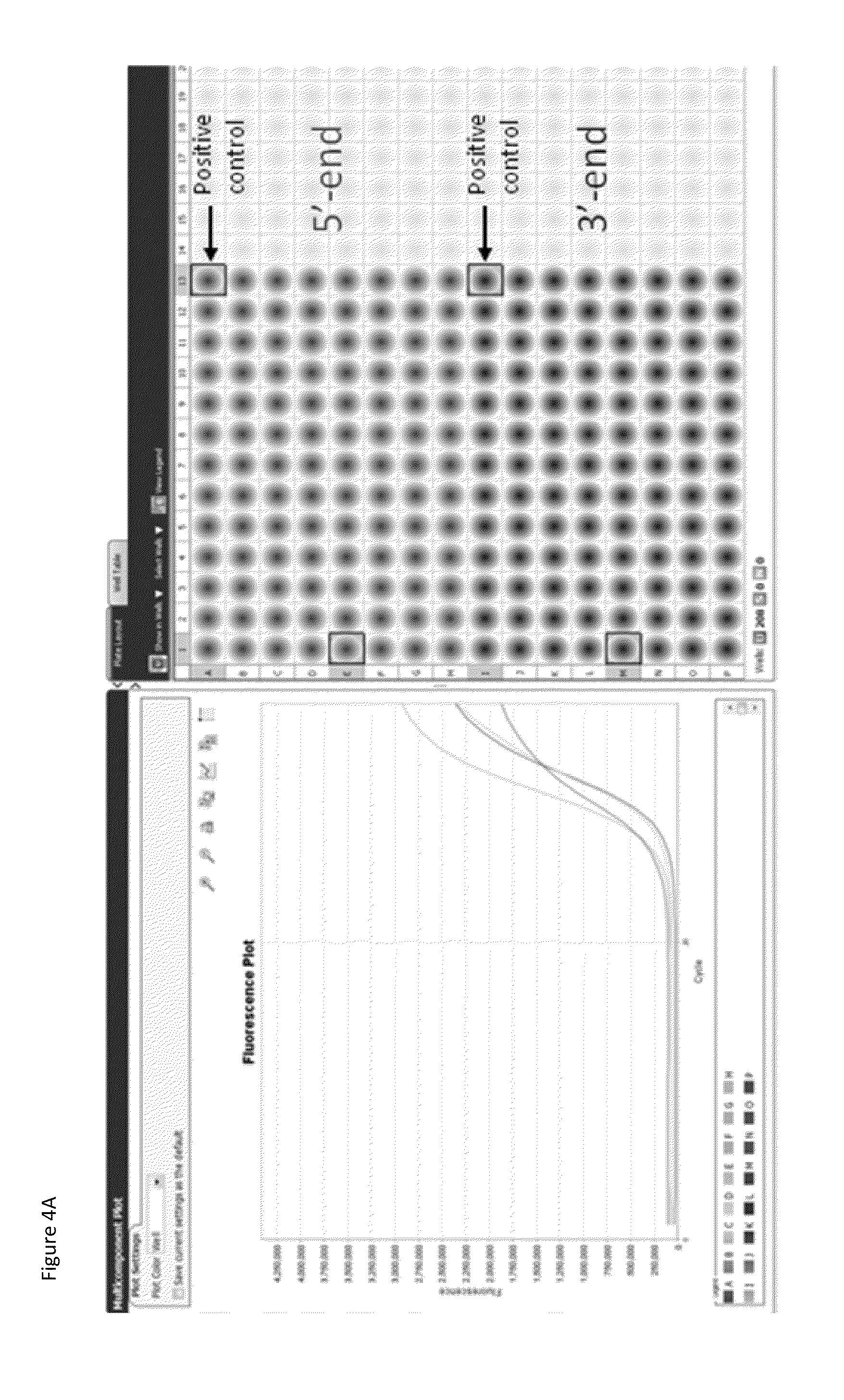DNA detection methods for site specific nuclease activity
a site specific nuclease and detection method technology, applied in the field of site specific nuclease activity detection methods, can solve the problems of low confidence outcome, inefficient targeting of plant genomic loci, inaccurate estimation of targeting frequency,
- Summary
- Abstract
- Description
- Claims
- Application Information
AI Technical Summary
Benefits of technology
Problems solved by technology
Method used
Image
Examples
example 1
Analysis of Targeted Loci in Maize Callus
[0204]Genomic Loci Targeting: The genomic locus for corn event DAS-59132 that was previously disclosed in WO2009100188 METHODS FOR DETECTION OF CORN EVENT DAS-59132, herein incorporated by its entirety, was targeted using a zinc finger nuclease designed to specifically bind and cleave the genomic DNA which makes up this event. The resulting transformants were maintained until an analysis to identify and characterize the disruption of the genomic loci within specific events via an amplification reaction could be completed.
[0205]The zinc finger proteins directed against DNA sequences which comprise the genomic locus for DAS-59132 were designed as previously described. See, e.g., Urnov et al. (2005) Nature 435:646-651. The DAS-59132 zinc finger designs were incorporated into vectors encoding a protein having at least one finger with a CCHC structure. See, U.S. Patent Publication No. 2008 / 0182332. In particular, the last finger in each protein ha...
example 2
Analysis of Targeted Loci in Maize Plants
[0225]Maize transgenic B104 embryos were generated, wherein the DAS-59132 locus was targeted via the Zinc Finger Nuclease construct, pDAB105906, and a donor construct, pDAB 104179. These constructs were transformed into the plant tissue using a biolistic transformation method as described in Example 7 of US Patent Application No. 2011 / 0191899, herein incorporated by reference in its entirety. Putatively transformed embryos were identified via selection of the herbicide phosphinothricin.
[0226]The putatively identified transgenic embryos were analyzed using the disruption assay to identify events which contained the presence of a donor DNA polynucleotide inserted within a targeted genomic locus. The ZFN disruption assay was completed using the protocols and reagents described above. In the events that were not targeted or disrupted, a target to reference ratio in the 0.4 to 0.6 range was observed; for samples that were disrupted or targeted a r...
example 3
Analysis of Targeted Loci in Maize Plants
[0229]Maize transgenic B104 embryos were generated, wherein an engineered landing pad locus (US Patent Application No. 2011 / 0191899, herein incorporated by reference in its entirety) was targeted via the Zinc Finger Nuclease and a donor construct were transformed into the plant tissue using biolistics. Multiple transformations were completed to target a donor construct within the engineered landing pad locus. The first series of transformations were completed using the pDAB109714 donor construct and the pDAB 105941 Zinc Finger Nuclease construct. A second series of transformations were completed using the pDAB 109715 donor construct and the pDAB 105943 Zinc Finger Nuclease construct. A third series of transformations were completed using the pDAB 109716 donor construct and the pDAB 105942 Zinc Finger Nuclease construct. The final series of transformations were completed using the pDAB109717 donor construct and the pDAB 105945 Zinc Finger Nucl...
PUM
| Property | Measurement | Unit |
|---|---|---|
| Molar density | aaaaa | aaaaa |
| Molar density | aaaaa | aaaaa |
| Concentration | aaaaa | aaaaa |
Abstract
Description
Claims
Application Information
 Login to View More
Login to View More - R&D
- Intellectual Property
- Life Sciences
- Materials
- Tech Scout
- Unparalleled Data Quality
- Higher Quality Content
- 60% Fewer Hallucinations
Browse by: Latest US Patents, China's latest patents, Technical Efficacy Thesaurus, Application Domain, Technology Topic, Popular Technical Reports.
© 2025 PatSnap. All rights reserved.Legal|Privacy policy|Modern Slavery Act Transparency Statement|Sitemap|About US| Contact US: help@patsnap.com



